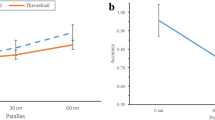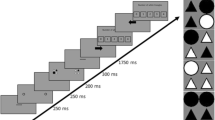Abstract
Purpose
A gaze shift from a target at distance to a target at near leads to pupillary constriction. The regulation of this pupillary near response is ill known. We investigated the impact of accommodation, convergence, and proximity on the pupillary diameter.
Methods
We recorded pupil size and vergence eye movements with the use of an infrared eye tracker. We determined the pupillary response in four conditions: (1) after a gaze shift from far to near without accommodation, (2) after a gaze shift from far to near with neither accommodation nor convergence, (3) after accommodation alone, and (4) after accommodation with convergence without a gaze shift to near. These responses were compared to the pupil response of a full near response and to a gaze shift from one far target to another.
Results
We found a reliable pupillary near response. The removal of both accommodation and convergence in gaze shift from far to near abolished the pupillary near response. Accommodation alone did not induce pupillary constriction, while convergence and accommodation together induced a pupil response similar to the full near response.
Conclusions
The main trigger for the pupillary response seems to be convergence. Neither accommodation nor proximity alone induce a significant pupillary constriction. This suggests that the miosis of the near triad is closely coupled to the vergence system rather than being independently regulated.




Similar content being viewed by others
References
Hung GK, Semmlow JL, Ciuffreda KJ (1984) The near response: modeling, instrumentation, and clinical applications. IEEE Trans Biomed Eng 31:910–919. doi:10.1109/TBME.1984.325258
Semmlow J, Wetzel P (1979) Dynamic contributions of the components of binocular vergence. J Opt Soc Am 69:639–645
Phillips S, Stark L (1977) Blur: a sufficient accommodative stimulus. Doc Ophthalmol Adv Ophthalmol 43:65–89
Fincham EF, Walton J (1957) The reciprocal actions of accommodation and convergence. J Physiol 137:488–508
Hess EH, Polt JM (1960) Pupil size as related to interest value of visual stimuli. Science 132:349–350
Marg E, Morgan MW (1949) The pupillary near reflex; the relation of pupillary diameter to accommodation and the various components of convergence. Am J Optom Arch Am Acad Optom 26:183–198
Marg E, Morgan MW (1950) Further investigation of the pupillary near reflex; the effect of accommodation, fusional convergence and the proximity factor on pupillary diameter. Am J Optom Arch Am Acad Optom 27:217–225
Stakenburg M (1991) Accommodation without pupillary constriction. Vis Res 31:267–273
Phillips NJ, Winn B, Gilmartin B (1992) Absence of pupil response to blur-driven accommodation. Vis Res 32:1775–1779
Backer WD, Ogle KN (1964) Pupillary response to fusional eye movements. Am J Ophthalmol 58:743–756
Wilhelm H (2011) Chapter 16 - Disorders of the pupil. In: Leigh CK and RJ (ed) Handb. Clin. Neurol. Elsevier, pp 427–466
Wilhelm H, Schaeffel F, Wilhelm B (1993) Age dependence of pupillary near reflex. Klin Monatsblätter Für Augenheilkd 203:110–116. doi:10.1055/s-2008-1045657
Knoll HA (1949) Pupillary changes associated with accommodation and convergence. Am J Optom Arch Am Acad Optom 26:346–357
Myers GA, Stark L (1990) Topology of the near response triad. Ophthalmic Physiol Opt J Br Coll Ophthalmic Opt Optom 10:175–181
Renard G, Massonnet-Naux (1951) Pupillary synergy to convergence. Arch Ophtalmol Rev Générale Ophtalmol 11:137–145
Tsuchiya K, Ukai K, Ishikawa S (1988) Concurrent recording of accommodative and pupillary responses elicited by quasi-static accommodative stimulation. Nippon Ganka Gakkai Zasshi 92:336–343
Schor CM, Alexander J, Cormack L, Stevenson S (1992) Negative feedback control model of proximal convergence and accommodation. Ophthalmic Physiol Opt J Br Coll Ophthalmic Opt Optom 12:307–318
McDougal DH, Gamlin PD (2015) Autonomic control of the eye. Compr Physiol 5:439–473. doi:10.1002/cphy.c140014
Horn AK, Eberhorn A, Härtig W et al (2008) Perioculomotor cell groups in monkey and man defined by their histochemical and functional properties: reappraisal of the Edinger–Westphal nucleus. J Comp Neurol 507:1317–1335. doi:10.1002/cne.21598
Büttner-Ennever JA, Horn AK, Scherberger H, D’Ascanio P (2001) Motoneurons of twitch and nontwitch extraocular muscle fibers in the abducens, trochlear, and oculomotor nuclei of monkeys. J Comp Neurol 438:318–335
Büttner-Ennever JA (2006) The extraocular motor nuclei: organization and functional neuroanatomy. Prog Brain Res 151:95–125. doi:10.1016/S0079-6123(05)51004-5
Acknowledgements
MA was supported by the Swiss National Science Foundation (320030-147023).
Author information
Authors and Affiliations
Corresponding author
Ethics declarations
Funding
The Swiss National Science Foundation provided financial support to MA (Funding Number 320030-147023). The sponsor had no role in the design or conduct of this research.
Conflict of interest
All authors certify that they have no affiliations with or involvement in any organization or entity with any financial interest (such as honoraria; educational grants; participation in speakers’ bureaus; membership, employment, consultancies, stock ownership, or other equity interest; and expert testimony or patent-licensing arrangements), or non-financial interest (such as personal or professional relationships, affiliations, knowledge or beliefs) in the subject matter or materials discussed in this manuscript.
Ethical approval
All procedures performed in studies involving human participants were in accordance with the ethical standards of the national research committee and with the 1964 Helsinki Declaration and its later amendments. The study was approved by the local ethics committee.
Informed consent
Informed consent was obtained from all individual participants included in the study.
Rights and permissions
About this article
Cite this article
Feil, M., Moser, B. & Abegg, M. The interaction of pupil response with the vergence system. Graefes Arch Clin Exp Ophthalmol 255, 2247–2253 (2017). https://doi.org/10.1007/s00417-017-3770-2
Received:
Revised:
Accepted:
Published:
Issue Date:
DOI: https://doi.org/10.1007/s00417-017-3770-2




